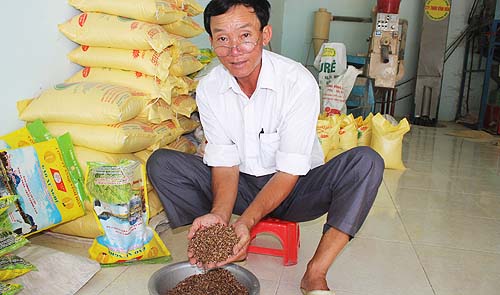After returning home from military service, a soldier in the central region of Vietnam spent over 20 years successfully creating the first-ever herbal rice variety in Vietnam. The type of seed was also the first of its kind anywhere in the world.
The former soldier is Phan Van Hoa, from Vinh Thanh Commune, Yen Thanh District, Nghe An Province. Hoa almost lost his house and all of his other assets while pursuing the dream and making it become true.
In explaining the dark violet color of the herbal rice seed, he said, “Generally, botanical products that are violet contain great amount of nutrition, especially Omega, which helps prevent heart disease and cancer. I am inspired by the function and was determined to create it.”
He was also the first person to successfully restore a purebred rice seed in Vietnam, which he named AC5.
Made-in-Vietnam herbal rice
In 1984 Hoa left the army as a wounded soldier and returned to his job as a farmer. Six years later, he was granted by local authorities to reclaim virgin soil in an area called Hoi Sac field. Though it was called ‘the field’, rice had never been cultivated there.
After remembering a popular proverb of ‘rice seed sowed on a tamed field’, Hoa decided to dig up ponds to raise fish. The first harvest went well, but he lost everything during the second thanks to saltwater intrusion.
He didn’t give up and applied for a bank loan and hired workers to build a dike to keep saltwater out. The first rice season on the field produced only flat grains of rice.
His wife, Phan Thi Loan recalled that, “At the time I spent all of time receiving creditors.”
“Thanks to the kind hearted director of the agriculture bank of the district, our house and other assets were not taken for compulsory sales. But Mr. Hoa refused to give it up.” she added.
Hoa decided to sell some of his assets to get money to buy a tractor. Thanks to the machine, Hoa carefully prepared his land and strengthened the dike, and the second rice season was a big success.
“I was happy and had money to begin creating herbal rice,” Hoa said.
Thanks to assistance from Professor Vu Tuyen Hoang, Hoa restored a purebred Vietnam rice seed called AC5, which up until then had only existed in a laboratory.
In 2005, he began cross-breeding AC5 with other domestic rice seeds on his ‘test field’ located inside his house, at the guidance of the professor.
Finally he reaped two rice flowers producing violet grains of rice, one of 176 grains and the other with 134 grains. He cultivated these grains on a two square meter area for multiplication.
Though the seed rice plants were later moved into a roofed area because of flood waters, the two square meters of violet rice produced a high output – around 370kg per 360 square meters, or 10.3 tons per a hectare. This yield is even higher than that of AC5.

Phan Van Hoa in his herbal rice field in Nghe An Province (Photo: Tuoi Tre)
The herbal rice seed changes the color of its leaves at different periods of growth, according to Hoa. The color of a seedling is light violet before turning dark green and then returning to dark violet as it blossoms.
“It is the color that made me almost go bankrupt,” Hoa recalled. “When they saw the seedling with its strange color, some farmers thought it was rotten and refused to grow it.”
Before it blossoms, when the color of the leaves turns from dark green to violet, farmers reported that the rice plants were infected with diseases and damaged by insects.
The spots on the leaves were the result of the changing of color, Hoa said, adding that he had to pledge to take full responsibility for any damages to persuade local farmers to keep the rice plants in the first crop.
“An expert from the local plant protection agency also confirmed that the spots on the leaves had resulted from a strange disease,” he recalled.
He named the violet herbal rice seed Vinh Hoa 1. Now, he has created several other herbal rice seeds with the names Vinh Hoa 2, 3, and 4.
Hoa has collected all of the violet rice at a price that is double that of normal rice seeds.
Test results
Samples of the violet rice were taken to Quality Assurance and Testing Center 1, under the Ministry of Science and Technology in Hanoi, to verify the content of lead, chemicals, and nutritional ingredients.
“It is really successful. All the indexes meet the standards,” he said.
Every 100 milligrams of violet rice includes 16.6mg of canxi, 1.1mg of iron, 57.0mg of vitamin A, 1,290.0mg of Omega 9, and 6.5mg of Omega 6.
Ph.D. Nguyen Van Tuat, vice director of the Vietnam Academy of Agricultural Sciences in Hanoi, said, “We named Vinh Hoa 1 functional food. The rice is nutritional and helps prevent some diseases.”



















































